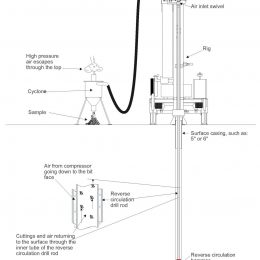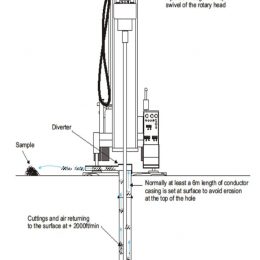Drilling Techniques for Mineral Exploration

In this article Dando looks at the three different types of drilling used for mineral exploration and the pros and cons of each. These drilling techniques are:
- Reverse Circulation (RC) Drilling
- Wireline and Conventional Coring
- Conventional Rotary Air and Mud Drilling
Reverse Circulation (RC) Drilling
Reverse Circulation drilling is probably the most common means of exploration drilling and is particularly popular in South America and Australia.
A dual wall drill pipe is used where air is injected between the two tubes by means of a “side inlet swivel”. The air exits the drill string just behind the bit whether it is a hammer or tricone. The air and cuttings are forced across the face of the bit and back up inside of the “inner tube” where they travel back to the surface out the top of the rotary head via a deflector elbow and along a discharge hose to the cyclone. Back at the face of the bit the air is prevented from rising up the annulus by means of a collar or shroud that in diameter is 1/8” smaller than the bit.
RC hammers are the most popular means of drilling although tricones are used in softer material or when the hammer “waters out” and will no longer function due to increased head of water entering the hole.
Requiring more equipment and greater drilling skills, RC works out more expensive per meter to drill compared to conventional drilling.
Wireline and Conventional Coring
Coring is a very old drilling method and the drilling parameters are much different to those used in RC and conventional drilling. A high rpm, typically 300 to 1200 rpm, is required. Weight on the bit and rate of penetration need to be constant to ensure the core is not washed away. In hard rock formations not enough weight risks polishing the bit, while too much weight can cause the bit to burn. This method therefore requires skill and knowledge of which type of bit to use.
Although less equipment is needed compared to RC drilling, diamond core drilling can command a very high cost per meter rate- much higher than Reverse Circulation drilling. The reason for this is because it is slow with high costs such as core bits, drilling additives, fuel and labour. On a good 12 hour shift maybe 30m can be drilled while during the same time 150m can be achieved using RC.
The two types of coring are:
- Wireline Coring
- Conventional Coring
Conventional Rotary Air and Mud Drilling
Perhaps the least expensive method of drilling, the conventional rotary technique is by far the simplest and requires limited skill. Despite these advantages, it is not the preferred method of drilling since it is not possible to obtain a representative sample.
Cuttings are removed from the bit face up the annular space between the drill pipe and the wall of the hole meaning that loose exposed formation further up the hole can fall in and be removed with the cuttings from the bottom therefore mixing with the specific depth sample and making the result questionable.



